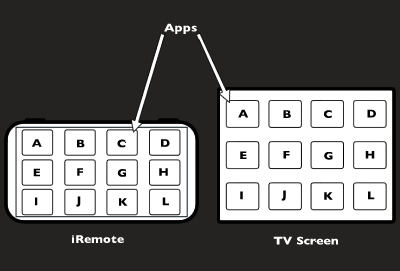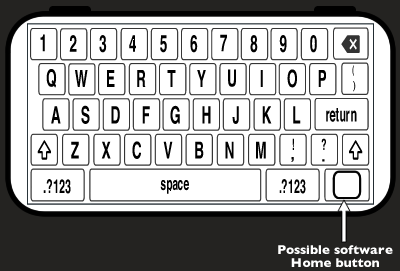The next battleground in the Apple vs Google war is the TV. Apple has had the Apple TV since 2006 (shipped in 2007) but Google is looking to launch Google TV later this year combining your “TV with the web” and allowing seamless search for media from different content sources. Google is leveraging their search strength but the rest of it is nothing new but a different direction none the less. Where does that leave Apple?
The new Apple TV
Apple TV was recently rumored to move to the iPhone OS and become a much smaller device with a focus on streaming video and possibly integrating iPhone and iPad games. This sounds great. Moving away from physical media to cloud services and media streaming with apps providing extra functions will make this a much better device than the current version. But how will you control this device?
The Remote Problem
Remotes today suck, especially for devices like Apple TV. The current standard Apple remote leaves much to be desired, but its simplicity is a testimony to the fact that the Apple TV interface is easy to use.
Using the standard TV style universal remote means configuring buttons to do different things, and adding special function buttons as well. This requires learning different combinations and remembering them when needed. A friend could walk into my living room and not even know how to turn on the DVD player, talk less about launching and watching something on the media device.
Media keyboards with the control stick/trackball on one side and buttons underneath or on the opposite side for use as a mouse with a qwerty keyboard are the closest to having more control of the device when using something like a media PC. This solution however means you will need to have a large keyboard within reach in your living room. Not a very pleasant solution.
People have suggested that just creating an app for the iPhone and Android devices would do. Maybe to browse through media, select shows, and change the channel once in a while. However, these devices are personal items and even if everyone in a household had an iPhone, there would be conflict about which iPhone is controlling the device and sharing would not so easily achieved.
Also, none of these solutions solves the problem of playing games which both these future platforms promise.
Imagine using any one of these remotes to play Android or iPhone OS games? Are you going to have to buy another remote/controller to add to the clutter just to play games? That means having two remotes, maybe even three if you get a separate keyboard to browse the web for just one media device.
No I think I will pass.
The Apple Solution
Apple already has the right type device to use as a remote. Its called the iPod Touch. However as it stands today a $199 entry price is high for a remote, but with a few modifications I believe this will be the perfect companion for the Apple TV. Introducing the iRemote (Sorry, I couldn't think of a better name to give it)
Features
Hardware
- A larger glass touch screen
- Cost less than $50
- A smaller custom HD or SD card (small capacity device)
- The original iPhone 412MHz processor or custom processor of comparable or higher speed
- Accelerometer
- Bluetooth and Wi-Fi radios
- Rubber/plastic padding to protect from drops and everyday use as a remote
- Large battery to last days without a charge
- Conductive charger (preferably built into the Apple TV device)
- IR for controlling non-Apple devices
- Two hardware buttons
Software
- IPhone OS Lite (a stripped down version of the iPhone OS or just a customized version)
- Support for multi-finger gestures
- Can be paired with other macs to act as remote
- Custom SDK for TV manufacturers to allow for control of their devices using the iRemote
Putting it Together
The iRemote is a companion device to the Apple TV. Its main function is to fill the gap between apps and a dedicated hardware device. It loads the controls necessary for the task being carried out on the Apple TV. For example, launching game controls when playing a game, or a keyboard when on an input box or acting like a trackpad when on a web page. This will be determined by the developer.
The device will have the same dimensions as the iPod touch but with the screen taking up a larger portion of the device. This will be achieved by either removing or moving the "Home" button, maybe even making it completely software based. This would allow for a larger keyboard on the device making it easier to type on it for most people using their thumbs.
The device will connect to the Apple TV either using the home Wi-Fi network or using bluetooth. Multiple iRemotes can connect to the same Apple TV allowing for multi-player games.
The device will not contain any apps except for a settings app to configure preferences and other restrictions.
The device needs a small hard drive and memory to carry out its functions. All components are selected to keep the price as low as possible while providing necessary functions.
How Does it Work
You come home from a long day at work and pick up the iRemote from the Apple TV conductive charging top. The accelerometer notices movement and iPhone OS Lite is launched giving you the option to turn on already paired devices such as your Apple TV, iMac or Mac Mini. You select the Apple TV and the device turns on.
You see your app selections on the TV but the iRemote shows smaller versions of the same icons on it's screen.
You swipe right looking for the iTunes store to stream the new episode of your favorite show. You click iTunes then the TV shows icon on the iRemote and it launches on your TV giving you a list of your favorite shows with new episodes first. This list appears on the remote and you click the show you want and it immediately begins to stream.
You get a notification that a new post on your favorite blog needs your attention. You pick up the iRemote and it shows the standard video controls with a button for the home screen. You click this and are immediately returned to the home screen with your video pausing. You then launch the web browser, open the bookmarks and select the blog. You begin to scroll on the remote, and the page scrolls on the TV. The iRemote becomes just like a Macbook trackpad.
The standard left and right mouse buttons appear on the iRemote screen or based on your configuration you can use the top hardware buttons. You double tap to zoom in, press and hold to select, pinch to zoom... All the standard touch interface gestures including two and three finger gestures. You touch the screen and hold, the circle navigation (instead of the generic mouse arrow) follows your finger to select a link or a piece of text just like in the iPhone OS. Once selected, you click again to follow the link.
You have something to say about the article so you click in the comments box and this immediately brings up a full screen keyboard on the iRemote while the site and comment box remain on the TV screen showing your text as you type.
Your best friend is at the door. He wants to play that new racing game you downloaded the other day. You click the home button and select the game. It loads on the TV and the iRemote immediately loads the controls for the game, using the accelerometer where necessary. He picks up the second remote, it launches and immediately detects the game asking if he would like to join as the second player. He selects yes and the game controls are loaded.
You push the left hardware button (again developer/user configurable) to accelerate and turn the iRemote just like you would any iPhone/iPod Touch to make turns in a racing game.
Its time for bed. You walk up to the Apple TV and drop the iRemote on top of it. It immediately begins to charge.
What?
The device will look and feel like an iPod Touch but with a larger screen and no home button restricting it's size. By putting all controls on the device, apps such as games and notes can run full screen on the TV while allowing for comfortable control from the couch. The device will be easily customizable to the user, allowing for ease of use, better controls and a familiar yet superior experience. Developers will have more room to build better controls for their applications without fear of these blocking the viewable area.
I don't know about you, but when the next Apple TV launches I would like for a companion device like this that comes bundled or at least doesn't cost $199 (base model iPod Touch).
The iRemote is a companion device that transforms into the controls for whatever app you are using. A keyboard, game controls, trackpad, tv remote. Anything you need to make the app easier to use on your TV.




